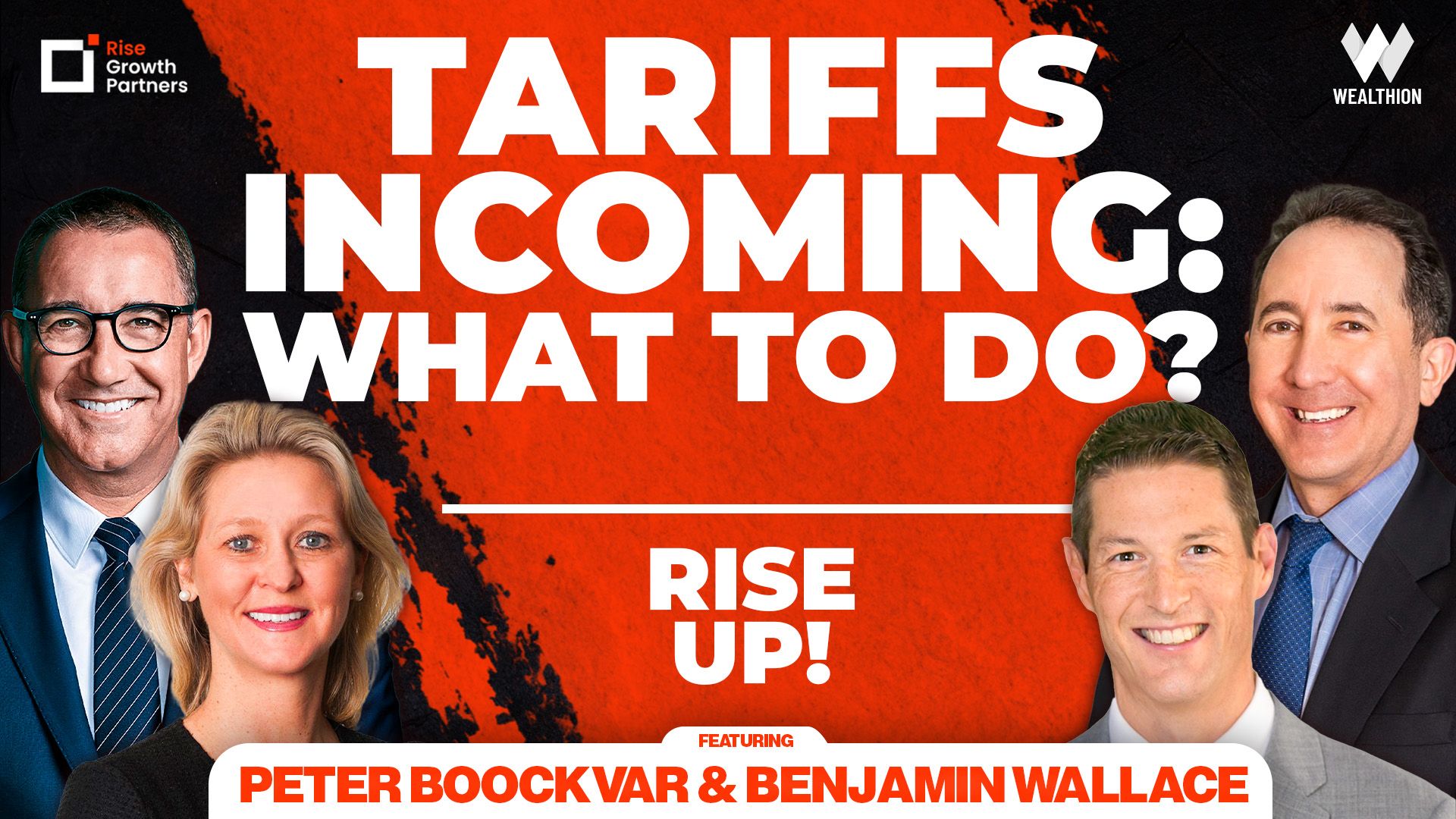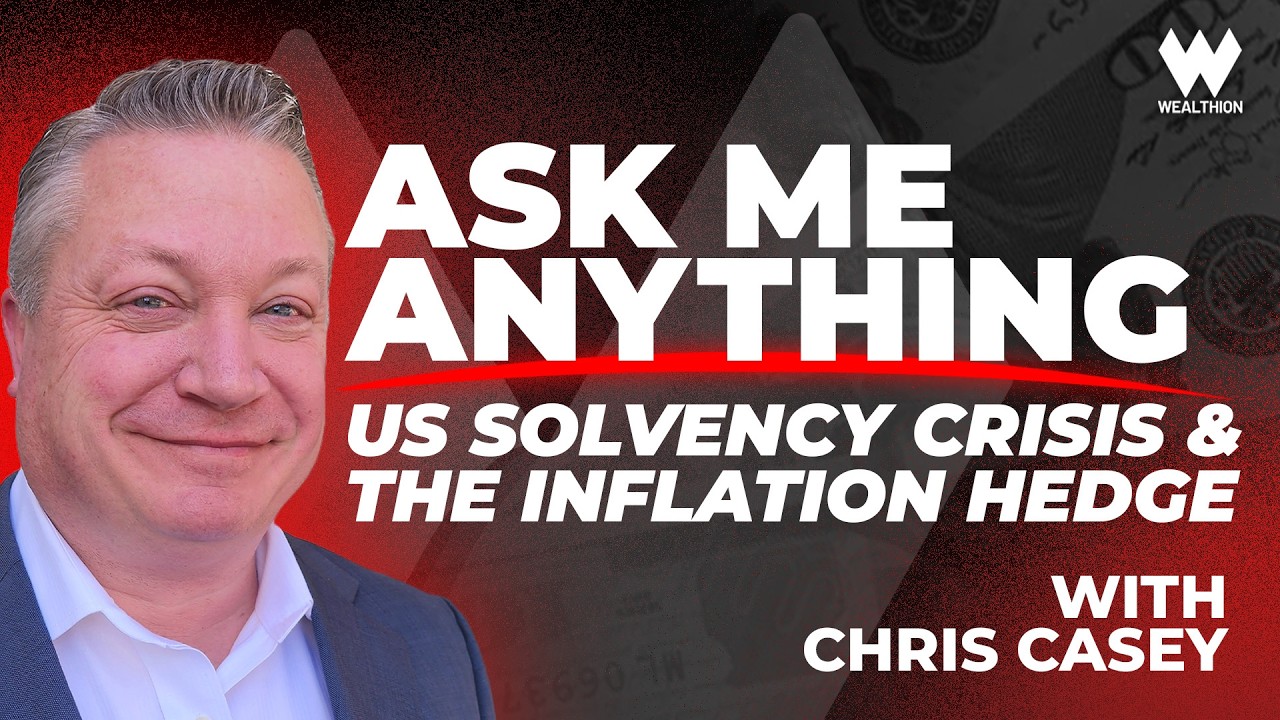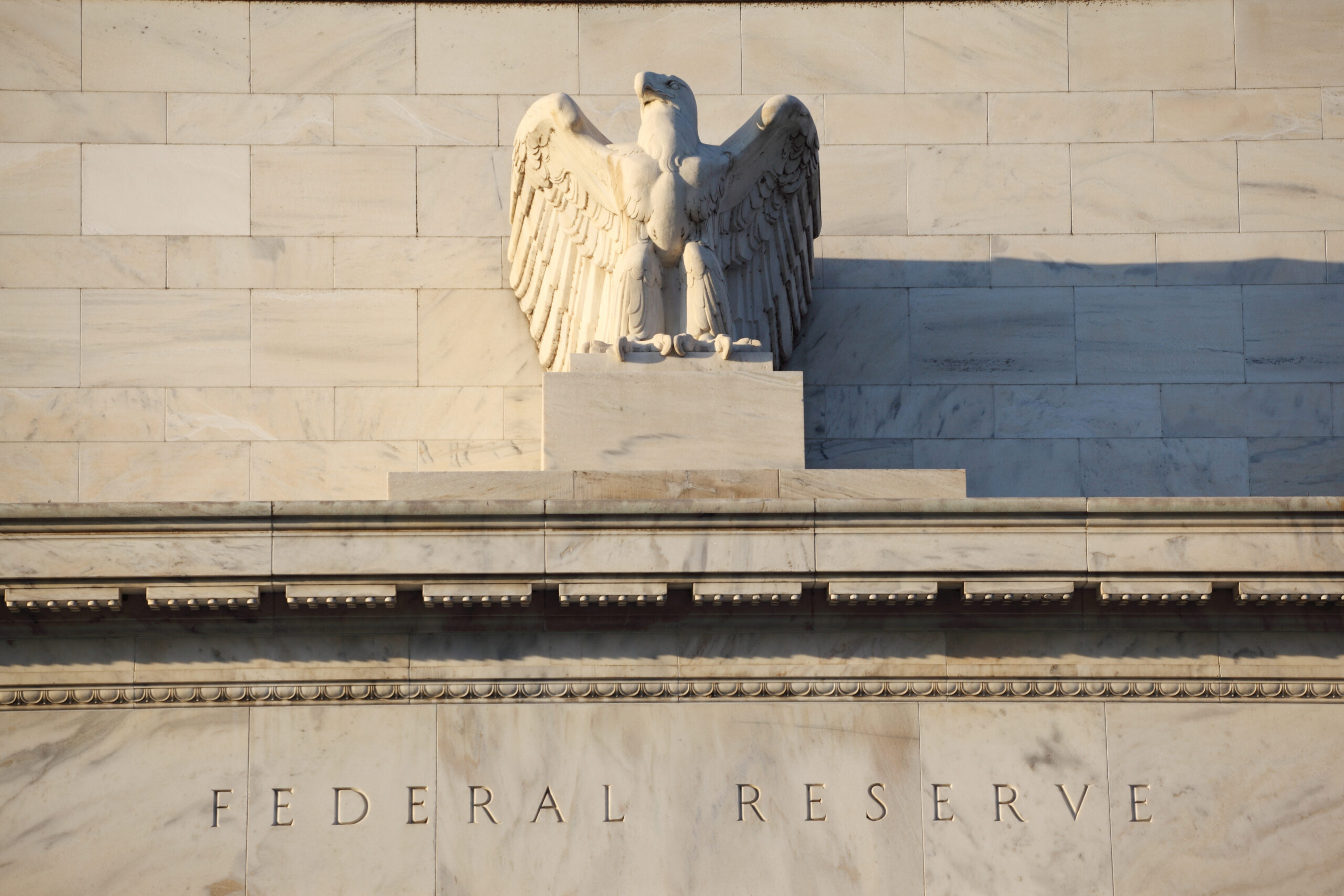Major tariff announcements are coming April 2 and markets are holding their breath. Is this the beginning of a renewed trade war? Or just a high-stakes negotiation tactic?
In this special edition of Rise Up, Rise Growth Partners’ Joe Duran and Terri Kallsen are joined by investment veterans Peter Boockvar of Bleakley Financial Group and Benjamin Wallace of Grimes & Co. to unpack what’s really going on—and how you should respond as an investor.
- The two possible tariff paths and their vastly different market implications
- Why uncertainty, not tariffs themselves, is the market’s biggest enemy
- The strange logic of Trump’s communication style: showmanship as a good sign?
- Why reversibility matters: could this all be walked back in weeks?
- What smart investors should do now: rethinking risk, value stocks, and diversification
What would you like to see on Wealthion? We want to hear from you! Please take our poll here.
Investment Concerns? Get a free portfolio review with Wealthion’s endorsed financial advisors at https://bit.ly/3FQIT1b
Terri Kallsen 0:18
Music. Welcome to rise up. This is a special edition. If you’re wondering why we’re appearing today, it’s because we’re hosting a very special edition of rise up on wealthy and to help you think through what’s going on today, the expected tariff announcements tomorrow, April 2. And no matter what you’re invested in, you will most likely be affected by some of these tariffs. And so our goal today is to help you think this through and know what action to take. Um,
Joe Duran 0:44
Liberation Day. Terry, it’s Liberation Day tomorrow. We’re finally free. Yeah, I like that. I’ve got tagline unusual, but here we are, here on on April 1. And I guess on purpose, Peter, he decided he didn’t want to make the announcements today. Wanted to move them to tomorrow.
Terri Kallsen 1:05
Well, Joe, I do, I understand. He did make an announcement today. He’s planning on adding tariffs to Chinese fortune cookies, because the when you get the information in Fortune cookies, it could be considered fake news. So he’s going to have tax fortune cookies now. So look out, everyone. This is coming your way.
Peter Boockvar 1:23
There’s a hoarding going on today, right? And
Terri Kallsen 1:27
it is April Fool’s Day. So you can decide if that’s true or not, but there seems to be tariffs. That seems to be the thing for everyone. So Joe, you know you’re a managing partner of CFA, the co host with me. We have also incredible guests with us today. I’m so
Joe Duran 1:41
excited about who we have today with Ben and Peter, both super brilliant investment minds managing billions and billions of dollars. I think it’s great that they’re going to talk a little bit about this. Obviously, this has been all the rage for the last month in the markets. Last six weeks, really, it’s become the signature thing other than immigration that that the government has been focused on, and tomorrow is D Day, you know, it’s the day, and we’ve priced in already, just to highlight a pretty significant amount of tariffs. We’ve already seen some imposed, especially on auto, 25% taxes on cars. But I think I’d like to highlight on three different pillars that we’re going to cover over the next little while here. The first one is how the team thinks about the size and scope of the actual tariffs. What do they anticipate will happen? And although none of us can guess, what are the implications of that? Number two is the certainty or the permanence of those are they a negotiating tactic, or is there certainty around? And the third is the style and delivery. How much does it matter the way that the President talks about these? So those three things, I think, are going to drive the feelings and the length of whether it’s a recovery, whether the market goes straight up or muddles around, but clearly, we’ve already priced in some level of slowdown. It’s already in the markets. And the question is, is this? Is this just a modest decline, or is this extended? Because that’s obviously where it really matters to people. Can’t do anything about the past, but let’s talk a little bit about tomorrow. Terry,
Terri Kallsen 3:20
well, the really, you know, you talked about, what are the actual tariffs? I mean, that’s a big one. And President, President Trump right now is saying all nations will face some form of reciprocal tariff, not just the 10 to 15 countries that had the worst trade imbalances. So this is really unclear, but you know, maybe what we should talk about now. It’s just the first one. What are the tariffs that are coming? Peter? Do you want to share some perspective on that?
Peter Boockvar 3:47
Sure. So specifically with April 2, it seems that it’s down to two possibilities. One is what they call, you know, evening the playing field in terms of the tariffs that they that they being import exporters to us and what we put on them to hopefully lower theirs relative to ours, rather than having to raise hours to where theirs is. I think the market would actually be very good with that, if the aggregate result is a global lowering of tariffs. The other question, though, is what the possibility for the second sort of tariff door may be, and that could be what’s being bandied about. And even Peter Navarro, the trade rep, talked about is a 20% wholesale tariff on all US imports of goods, which would total about $600 billion per year, spread out over, you know, particular time frame. If they were to implement that, I think the market would be less happy with that, but the administration’s perspective and purpose for that would be to apply that that sort of income to paying to extend the expiring tax cuts at the end of the year. So they’re actually two different tariff lanes that are being debated here. Year, and I think they should be treated differently. And we’ll obviously see tomorrow, four o’clock pm Eastern, which road they choose.
Joe Duran 5:09
And I’d like to double click on that. I think it’s a very interesting idea that this is a about evening the playing field, or B, about generating revenue, which B is really a tax, right? Like the way to think about, if this is really about just generating revenue, the payers for that are typically the corporate America and the consumers like the government is not collecting money from anyone else, other than the people who are actually buying the stuff or selling the stuff, which is all of us. So I think that’s a very interesting measure. Peter, how do you think about it? Ben, is that a fair interpretation? And how should we think about it? If he leans most on evening the playing field versus most on generating revenue? And how should you interpret that? Because I think it’s a very interesting lens.
Benjamin Wallace 6:00
Yeah. So whenever I’m talking to clients about what tariffs are, I always say that the big positives that people were looking for out of the Trump administration were lower taxes, lower regulations. That was what worked in Trump round one, and that’s what people were looking forward to in the fourth quarter of 2024 after the election. I always point out to folks the nice thing with the tariff is it’s actually a tax and a regulation at the same time, right? It’s a tax on individuals, what they’re what they’re spending, as you just noted, it’s also regulation. It’s telling businesses where they should or shouldn’t be doing something, and it factors in as a new decision making process for them, and another, another thing they’ll have to think about. So I think the biggest thing that people are looking for, and all the uncertainty that we’re talking about. And I think Peter laid it out really well. You take this step back, people want to know what the logic is, because we’ve heard it’s about the border. We’ve heard it’s about fentanyl. We’ve heard it’s about evening out trade deficits. We’ve heard it’s about funding the deficit. We can speculate what they are, but we actually don’t know what they are, and that’s what we’re going to be looking to find out tomorrow. So yeah, I mean, if it’s, if it’s geared towards leveling the playing field, getting everyone to lower their tariffs globally, putting us on it, on a fair base for competition, I think that would be seen as a positive if it’s being seen as more as a way as punishing, come punishing other countries, punishing companies, punishing individuals, for whatever the reason is, whatever the affront they’ve done. I think that’s that would be where it’d be more damaging. And I think the last thing which you talked about this is really what the market’s wrestling with this whole tariff debate. Most of what we’re talking about is which is a good thing is reversible. All the things that they can announce, they can turn around two weeks later and take it all back. So that’s adding to the uncertainty. So that’s why the permanence, you know what? What is the goal? If the goal is just to improve trade, you know what? That tells me? That tells me it’s more likely to be a reversible trade, right? We’re going to negotiate. We’re open for business, we’re ready to talk, right? And there’s, there’s been plenty of quotes to that effect, even over the past weekend. Um, but if it’s really like, Nope, we want to get rid of trade deficits. We think, you know, we trade too much with Canada. We trade too much with Mexico. That’s why we started off with those two countries. Um, then that’s going to be seen as a much more, longer term, much more of a challenge for businesses to adapt. And that’s what we’ll be seeing negatively.
Joe Duran 8:22
Really interesting insight.
Terri Kallsen 8:23
Yeah, so let’s talk a little bit about, you know, the likelihood, if these tariffs go through, what is the likelihood they’ll actually stick? Or can we predict on some of these? So, Joe, what are your
Joe Duran 8:34
thoughts? Well, again, I think Ben has outlined it beautifully. It’s it’s not really what happens. It’s how we interpret what’s going to happen. The market hates uncertainty, so if it is actually just a back and forth so that everyone lowers tariffs, we’re trending in a direction like, well, this is bad as it’s going to be, because it’s going to get better, because either the countries are going to reduce their tariffs to match ours, and it won’t matter. It’s generally good for business. So it’s just for us as investors, for for us as business owners, for companies investing in their businesses. The unknowing is the biggest problem. If it’s not knowable, you don’t know whether you should like Ford is not going to start manufacturing cards in the United States. Because to build a factory. If the Democrats come in three years from nine or four years from nine, change the rules, they’re going to go back to producing that. So they need to know the likelihood of it sticking. And I think Ben did a great job. Peter, great setup, honestly. How do you think people should be operating as as to like how to interpret whether this is going to drag on for months and months without knowing what to do. But to me, the key is what businesses interpret from this, from the rules, because businesses are quick to adapt, but they need to know what they’re adapting to. So how should what should we look for tomorrow? To give a read of like, okay, you. Water is blue, we’re good. We can jump back in again.
Peter Boockvar 10:02
Well, I think we need to hear whether April 2 is it, whether they’ve laid out all their sort of tariff cards on the table, and that’s what we’re going to get now. They’re going to sell it as something permanent, because if they don’t, then businesses aren’t going to change their ways in response, and they’ll try to wait it out to see if there’s a change in Congress in 2026, and so on, because there’s also a legal thread that flows through this. The President doesn’t have authority to lay on tariffs unless there’s a quote, unquote national emergency. So it’s very possible that whatever we even hear tomorrow is going to end up in the courts at some point, as people Sue and say, well, there is no national emergency here, but to your point, Joe, yes, businesses, regardless of what we’re going to hear, they just want to know. They just want to know what suppliers they’re going to procure their products from, how much it’s going to cost them to shift something from point A to point B, and how much of a price increase is their their consumer going to be able to adapt to? Now, from an investor standpoint, we do have some experience with this, right, but not to the same extent 2018 we had a previous tariff battle. It negatively impact manufacturing that led to Fed rate cuts in 2019 so there is some experience with this, but I think it’s important, from an investor standpoint, is don’t look at this in isolation. Look at it as part of a broader picture. Look at it where is where it’s happening in the context of interest rates, where is it happening in context of how mag seven stocks are trading, and where international investors are looking it’s part of a broader mosaic that this is going to help fill in tomorrow. Okay,
Joe Duran 11:44
Ben, I want a question. Obviously we want to get into what people should do, but I am curious. Politics is a show economics is reality and tomorrow. I think it matters whether we get Donald Trump president and showman or DONALD TRUMP, President and rule maker. So which version do you think you’re going to get, and how should we interpret what his delivery style? Because obviously we’ve seen many versions of how he likes to present things. So what, what do you what do you expect to see? And how should we interpret each each version.
Benjamin Wallace 12:21
Well, I think it’s somewhat ironic. I think the more extravagant and showmanship there is to it, you know, the more we’re talking about, you know, other countries are ripping us off, etc. You know, we have issues with this country, with that country. I think the more extravagant it gets, that’s actually the more positive, because it means there’s more room to then come back and have a negotiation, because a negotiation is a great show too, right? You know, sitting around a boardroom table, I think, I think President Trump knows a thing or two about making that into a show. But so I think the more it’s laid out, and the more it said, Well, here’s how you can fix it. I think that’s where the positive lies. So that’s, it’s, it’s a strange way to interpret it, but I think that’s where we’re headed. Whereas if you just stands up there and show some show some charts, you know, a couple numbers, and says, This is what we’re focused on, I think people would, would, would actually be a bit more concerned, because, like, Nope, this. They’re very hard and set on this. But I do think the goal is to set up some type of a negotiation, because that way the show continues. You always want to have new episodes, right?
Terri Kallsen 13:26
Let’s talk about that. The next show you know, Ben, you’re working with clients each and every day. Peter, you’re helping investors think through I mean, there are some clearly risk here. You know those businesses that rely heavily on imports, manufacturing, automotive, consumer discretionary sectors, we may think about diversification into defensive stocks like utilities, healthcare, consumer staples may be more resilient, but are your clients panicking? And what are you telling them to do?
Benjamin Wallace 13:59
So I would, I wouldn’t say our clients are panicking. I think most of the calls that we have are just people who are concerned. And it’s, it’s, it’s the nature of politics, which you which you let off with. It creates a lot of really big headlines. It’s all over the news. And it’s human nature. You see a story like that, anything geopolitical, people see it and they want to do something. They feel like they need to do something. It’s a human need, right? You see something going on. I have to take action. We’re hardwired. We’ve been doing this for, you know, for millennia. But the important thing is, you need to have a pre existing plan. If a, you know, we’ve only had a 10% pullback from the peak in the equity markets. We’ve only had a little bit of volatility here. If this type of movement is is causing an issue with your portfolio, there’s probably something wrong with your portfolio. Maybe your portfolio is fine, but it’s not the right portfolio for you, or you need to think about, you know, where you are positioned, because we’re always saying, you know, when clients are in a period of emotional distress, that’s not when we want to make decisions on them. That’s when mistakes get made. That’s when people go off their path, right? So it’s important to have a sense of where you are and what you want to be positioned for, and and then be in a position so that you don’t have to think about these short term movements, these short term issues. So if you have expenses coming up, you should have your three to six months of expenses in cash, you know, little things like that. And again, these are really basic bits of advice, and it’s kind of boring. But we like being boring. We’re happy being boring. Peter,
Joe Duran 15:27
what do you think should people do? What should they be doing during tomorrow? After tomorrow? It’s a do nothing. Or what would you suggest it?
Peter Boockvar 15:38
Well, I you know, like I want to say, do nothing, because we don’t want to invest our our politics. But, you know, Joe, you made a great point before that, there’s there’s politics, but then there’s real substance. You know, markets are, are very unemotional. They look at what will directly impact economic growth and earnings. How many more phones or less phones? Is Apple going to sell in response to a particular policy? And there’s no doubt that tariffs will have a direct impact on economic activity. So I think it’s it’s smart for investors to sort of not be overly positioned or concentrated in what used to work, because the market’s changing right now, the max seven trade is no longer the dominant driver of markets, and I think that is a multi year trend. So if you’re using that sort of playbook, thinking that everything’s going to be fine, we’ll get through this like that. I think that is not necessarily going to work, but having international stocks, having value stocks, and that’s the one thing about a value stock relative to a growth stock. A value stock inherently has lower embedded expectations, so whatever externalities come our way owning a value stock, well, that stock is already priced in a lot of negative news relative to a growth the high multiple stock that is more vulnerable to external shocks. But I do want investors to understand that not everything stays the same. There’s not always this linear path. Markets go through transitions. Markets go through times of consolidation. And I think we may be in the midst of one of those time frames. And I’ll
Joe Duran 17:13
highlight like, where PE multiple today, on the S, p5, 100 is 20 times, and even on the equal weighted which, which recalibrates and reduces Magus impact. It’s 16 times. Now those are frothy levels, and so uncertainty causes the market to say we’ve got to come down. And so we were at 23 times. We’re now at 20. So it’s more reasonable. We’re still on the high end of pricing. And as I think both Peter and Ben have pointed out, don’t do anything rash. Emotions aren’t good for your health. But think about the fact that the playbook going forward might need to be different, like I remember 99 and 2000 when there was the bursting of the Nifty 50 trade all the big tech heavy companies, which today are represented in large part by what’s happening with AI and that bubble pulling out. But value stocks did fine in that time. International stocks did fine in that time. So again, I think we’re going through an existential crisis, and obviously work with an advisor to make sure that you make prudent, calm, deliberate choices, because this shift is a multi year shift. It’s not just a few months. And no decision should be made overnight. I should move to cash right now. Sell on my mag seven stocks like we need to have thoughtful, careful consideration for these changes that might have an impact of yours. So I think it’ll be an interesting we’ll all be on bated breath. We have already priced in a lot of chaos. But I haven’t seen what I typically like to see at the end, which is an OH GOSH day, you know, vix sitting in the mid 30s. We have not seen that yet, so I would not be surprised if we get a lot of noise in the next rest of this week, as we said, stabilize. So you guys were great as always.
Terri Kallsen 18:59
Yeah. Thank you both very much, both Ben and Peter and Joe. Today was a really a special edition to give you some information for you to be able to understand what’s happening over the next couple days, but we will be here again later this week with our regular show. So I’d invite you again to tune in now after the tariffs go into place on April 2, to determine what are the next steps? So thank you for watching our very special report. These are uncertain times. You know, the one thing that is common we continually tell our viewers is, go see your advisor, see a fiduciary, understand your portfolio. And if you’re not sure, go to wealthion.com backslash free to get a free portfolio review and we can help you work through this. Thank you so much for watching.
Joe Duran 19:44
Thanks team. Thank you all
Benjamin Wallace 19:46
right. Thank you very much. You.



